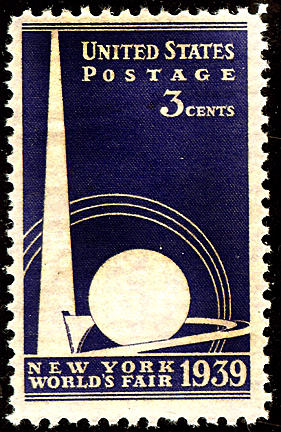 On
June 1, 1933, James A. Farley, Postmaster General, opened the Century of
Progress Exposition in Chicago as President Franklin D. Roosevelt’s
official representative. He probably visited the post office display
with its complete set of U.S. proofs in the Federal Building and one of
the many postal stations where fairgoers could purchase stamps and
obtain special postmarks, including one in a railway mail car exhibit.
On
June 1, 1933, James A. Farley, Postmaster General, opened the Century of
Progress Exposition in Chicago as President Franklin D. Roosevelt’s
official representative. He probably visited the post office display
with its complete set of U.S. proofs in the Federal Building and one of
the many postal stations where fairgoers could purchase stamps and
obtain special postmarks, including one in a railway mail car exhibit.
The United States Post Office Department
(United States Postal Service since 1971) played a major role in
America’s world’s fairs by issuing postage stamps to promote and honor
the international expositions and their themes, by exhibiting the
history of postage stamps and postal operations in the Federal Building.
It operated postal stations on the fairgrounds for both visitors and
concessionaires. The U.S. Postal Service issued its first commemorative
postage stamps for the 1893 Columbian Exposition, thus creating a change
in the postage stamp program.
The Beginning of Commemorative Stamp
Collecting
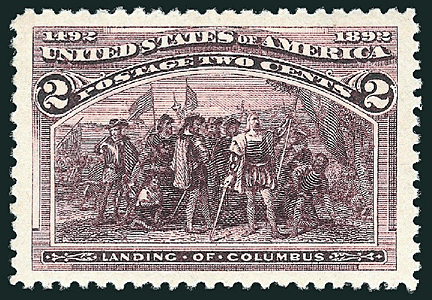 Stamp
collectors who collect U.S. commemorative postage stamps begin their
collections with stamps issued to honor the World Columbian Exposition
in Chicago, held in 1893. Most stamp collectors, however, don’t collect
World’s Fair stamps as such—known as a topical collection—but instead
collect them as part of a more general collection.
Stamp
collectors who collect U.S. commemorative postage stamps begin their
collections with stamps issued to honor the World Columbian Exposition
in Chicago, held in 1893. Most stamp collectors, however, don’t collect
World’s Fair stamps as such—known as a topical collection—but instead
collect them as part of a more general collection.
In addition to regular and commemorative postage stamps, collections may
also include die proofs, certified plate proofs, postal stationery, and
special exposition postmarks on envelopes, known as First Day Covers..
All of these objects document the postal history of the Fairs and
provide graphic imagery that depicts the various themes and aesthetic
styles of the Fairs.
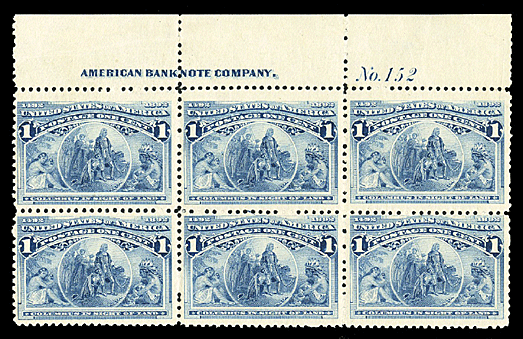
Besides the Fair commemorative stamps themselves, some collectors
specialize in collecting First Day Covers issued and postmarked at the
Fairs. A First Day Cover is an envelope with a particular commemorative
stamp attached that’s postmarked, or franked, by hand with the official
frank of the day the stamp first appeared.
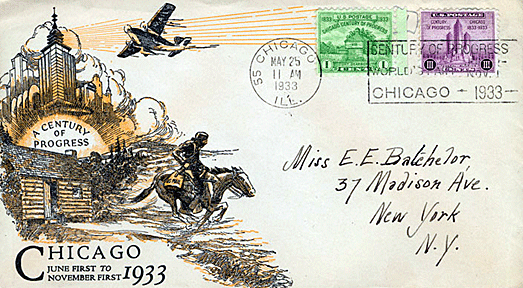
These can range from one with the official stamp of a particular fair to
stamps commemorating specific pavilions, exhibits, shows, groups,
distinguished guests, and events held at the Fairs. They can even honor
specific topics related to a Fair.
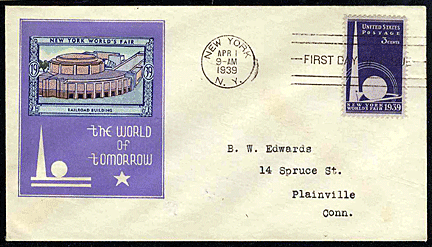 While
a First Day Cover can show just the stamp and its special First Day
cancellation, most also include an illustration, called a cachet,
covering the left front side of the envelope. While some of these are
rather plain images, perhaps one of a Fair’s distinguishing features,
such as the Trylon and Perisphere from the 1939-40 New York World’s
Fair, others are quite elaborate color designs by noted cachet artists.
While
a First Day Cover can show just the stamp and its special First Day
cancellation, most also include an illustration, called a cachet,
covering the left front side of the envelope. While some of these are
rather plain images, perhaps one of a Fair’s distinguishing features,
such as the Trylon and Perisphere from the 1939-40 New York World’s
Fair, others are quite elaborate color designs by noted cachet artists.
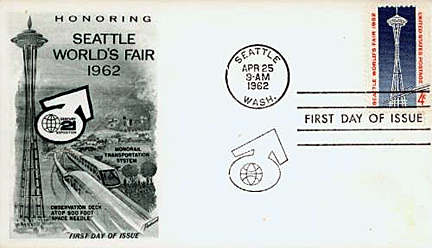 Fairgoers
could take a letter or postcard, with a message to the folks back home,
to one of the Fair’s postal stations and have it cancelled and mailed
home right from the Fair. If they did this on a particular First Day of
issue, they essentially received their very own personal First Day
Cover. And many stamp collectors did just that.
Fairgoers
could take a letter or postcard, with a message to the folks back home,
to one of the Fair’s postal stations and have it cancelled and mailed
home right from the Fair. If they did this on a particular First Day of
issue, they essentially received their very own personal First Day
Cover. And many stamp collectors did just that.
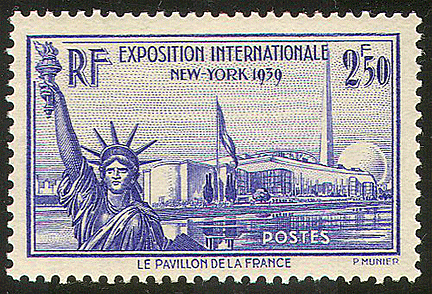 The
Postal Service issued First Day Covers every day a Fair was open of all
the American World’s Fairs beginning with the World’s Columbian
Exposition in 1893. Each one commemorated a different topic, pavilion,
or event at the Fair, and received its own special ceremony marking the
event.
The
Postal Service issued First Day Covers every day a Fair was open of all
the American World’s Fairs beginning with the World’s Columbian
Exposition in 1893. Each one commemorated a different topic, pavilion,
or event at the Fair, and received its own special ceremony marking the
event.
Of course, foreign nations participating in each Fair also issued their
own commemorative stamps which fairgoers could often purchase at their
pavilions.
The First Set of Commemorative Stamps
The U.S. Post Office Department outdid itself with that set of 16
postage stamps, plus a special delivery stamp and postal stationery,
publicizing the World Columbian Exposition. While many collectors loved
the set, just as many did not, mostly because of the number of stamps,
their large size, and the high face values for which there was doubtful
need at the time.
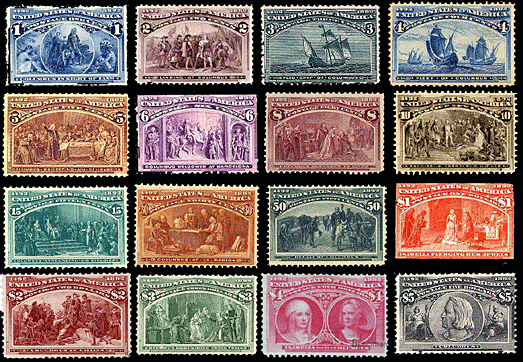
The total cost of a mint set of the 16 postage stamps was $16.34 at a
time when the average worker made less than that in a week. The set
included stamps denominated at $1, $2, $3, $4 and $5.
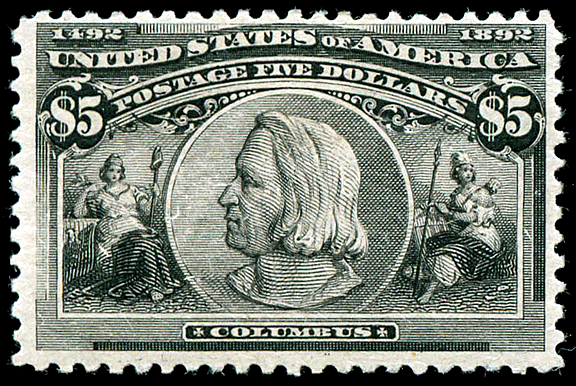
This caused the philatelic press of the
time to suggest that the Columbian issue would cause the death of stamp
collecting. Stamp clubs passed resolutions condemning the issue, and the
issue gave birth to the Society for the Suppression of Speculative
Stamps.
Yet, today, the Columbian issue is one of the jewels of a high-level
U.S. stamp collection, each stamp selling for hundreds and often
thousands of dollars, the higher denominations going for the most.
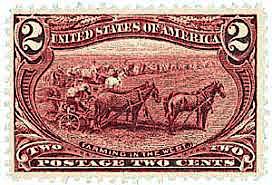 The
Post Office Department, as the U.S. Postal Service was known at that
time, did pay attention to the criticisms. In 1898 when it celebrated
the Trans-Mississippi Exposition, there were “only” nine stamps in the
set and the top denomination was $2.
The
Post Office Department, as the U.S. Postal Service was known at that
time, did pay attention to the criticisms. In 1898 when it celebrated
the Trans-Mississippi Exposition, there were “only” nine stamps in the
set and the top denomination was $2.
But there was still negative feedback. The Society for the Suppression
of Speculative Stamps recommended that collectors refuse to purchase
these stamps and thus assist in preventing future issuance of stamps
intended mainly for the purpose of sale to stamp collectors and
speculators. Although the Society for the Suppression of Speculative
Stamps faded away, it may have had an effect as exposition issues were
much more restrained after 1898.
Favorite World's Fair Postal Issues
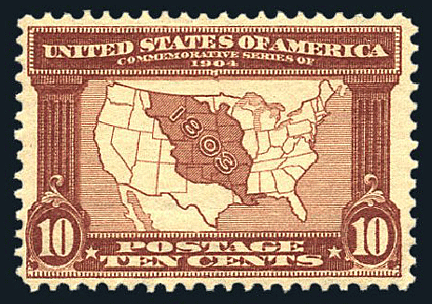 One
that’s a favorite of many collectors is the Louisiana Purchase
Exposition issue of 1904. Held from April 30 to Dec. 1, 1904, it was
also known as the St. Louis World’s Fair. The set included five stamps,
with the highest denomination being 10 cents.
One
that’s a favorite of many collectors is the Louisiana Purchase
Exposition issue of 1904. Held from April 30 to Dec. 1, 1904, it was
also known as the St. Louis World’s Fair. The set included five stamps,
with the highest denomination being 10 cents.
For most expositions, collectors can collect cancellations, postcards,
and Cinderellas, or labels that look like stamps, in addition to the
commemorative stamps and First Day Covers.
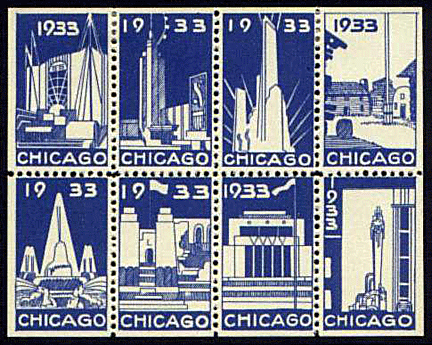
The Postal Service produced a series of postal items for the Century of
Progress Exposition in 1933. In addition to the individual stamps, it
issued commemorative sheets.
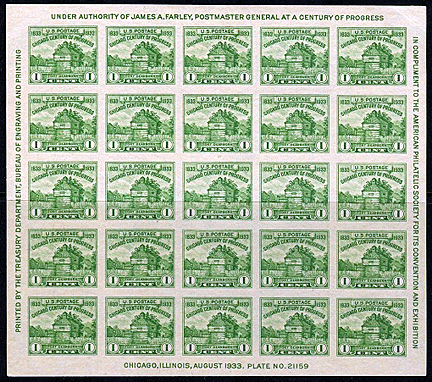
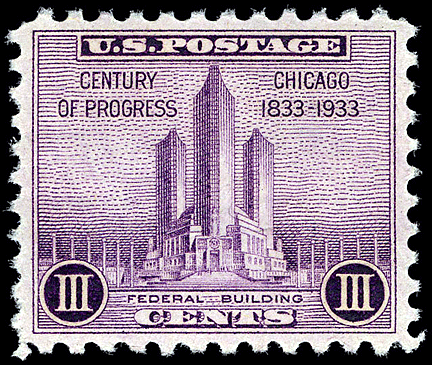 The
U.S. Post Office Department issued three stamp designs for the 1933
fair, with a total of seven varieties. On May 25, 1933, a 1-cent stamp
for the postcard rate and a 3-cent stamp for the letter rate promoted
the fair just days before it opened. The green 1-cent stamp depicted
Fort Dearborn, which had protected the mouth of the Chicago River in the
pioneer days and had been restored in 1816. A replica of the fort was a
popular attraction at the fair. The violet 3-cent stamp’s vignette
featured the fair’s streamlined Federal Building. Its three fluted
towers represented the three branches of federal government—executive,
legislative, and judicial—and inside it housed government exhibits. The
3-cent denomination was in Roman numerals, the first U.S. stamp since
the 1847 10-cent George Washington to feature that.
The
U.S. Post Office Department issued three stamp designs for the 1933
fair, with a total of seven varieties. On May 25, 1933, a 1-cent stamp
for the postcard rate and a 3-cent stamp for the letter rate promoted
the fair just days before it opened. The green 1-cent stamp depicted
Fort Dearborn, which had protected the mouth of the Chicago River in the
pioneer days and had been restored in 1816. A replica of the fort was a
popular attraction at the fair. The violet 3-cent stamp’s vignette
featured the fair’s streamlined Federal Building. Its three fluted
towers represented the three branches of federal government—executive,
legislative, and judicial—and inside it housed government exhibits. The
3-cent denomination was in Roman numerals, the first U.S. stamp since
the 1847 10-cent George Washington to feature that.
Another stamp issued to honor an event at the Fair was the 50-cent green
Graf Zeppelin stamp, depicting the famous German airship over the
Atlantic Ocean with the hangar at Friedrichshafen at right and the
Federal Building from the Fair at left. The Zeppelin Company (Luftshiffbau
Zeppelin G.m.b.H.) agreed to fly to Chicago during the Fair if the U.S.
Post Office Department issued a special postage stamp to help offset the
expenses of the flight. As a result, 42½ cents of the 50 cents went to
the Zeppelin Company.
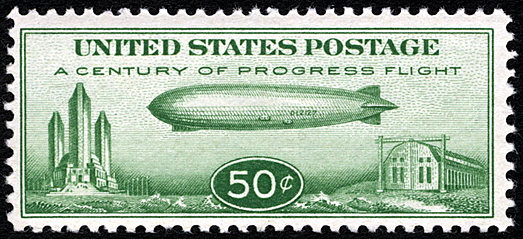
The stamp had its First Day of issue on October 2, 1933, in New York
City, in time for mail to be sent by ship to Germany for transport by
the zeppelin. Washington, Miami, Akron, and Chicago also had first days
of issue. U.S. mail could also be dispatched from Miami, Akron, and
Chicago for various legs of the flight, using a combination of one to
four stamps to pay the different rates. Envelopes received different
rubber-stamped postal cachets as evidence that the mail had been carried
on different legs of the flight.
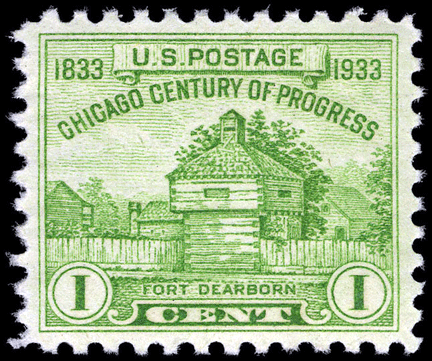 The
Federal Building shown on the stamp is similar to the one on the 3-cent
stamp. Victor S. McCloskey, Jr., designed both stamps, but different
engravers translated the models to dies. The Federal Building on the
Zeppelin issue had different proportions with a shorter center tower and
an elevated entrance. Perhaps to reflect the popularity of the fair, it
shows more fairgoers on the steps. The stamps had flat plate printing in
plates of two-hundred subjects with four panes of 50 each.
The
Federal Building shown on the stamp is similar to the one on the 3-cent
stamp. Victor S. McCloskey, Jr., designed both stamps, but different
engravers translated the models to dies. The Federal Building on the
Zeppelin issue had different proportions with a shorter center tower and
an elevated entrance. Perhaps to reflect the popularity of the fair, it
shows more fairgoers on the steps. The stamps had flat plate printing in
plates of two-hundred subjects with four panes of 50 each.
The three stamp designs not only promoted the Chicago World’s Fair, they
also promoted the idea of progress. The 1- and 3-cent stamp images
contrasted the old federal government to the New Deal government of
1933, emphasizing the changing and improved role of government services.
The Zeppelin embodied technological progress as the world’s largest
flying craft.
< Back to Collecting Archives
Next Article >
